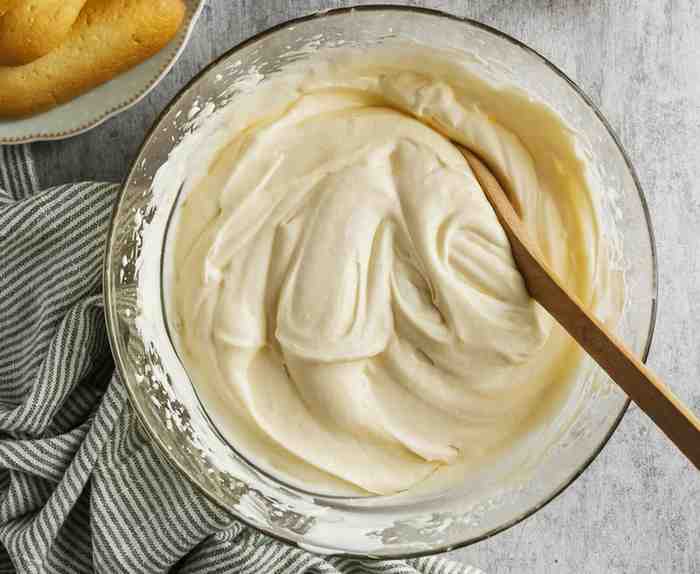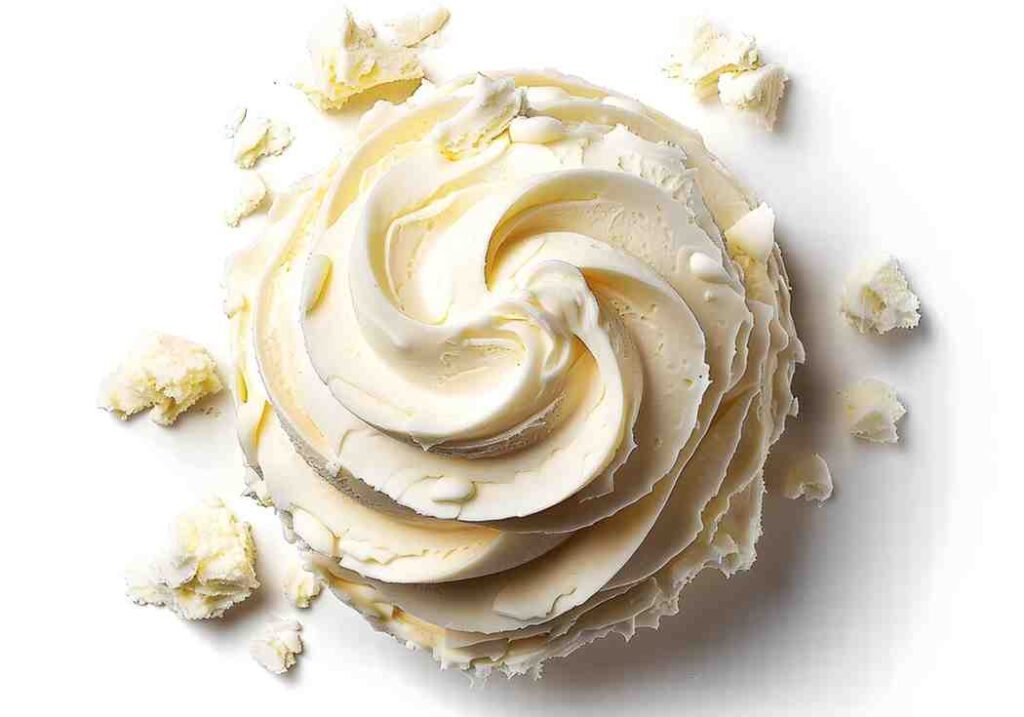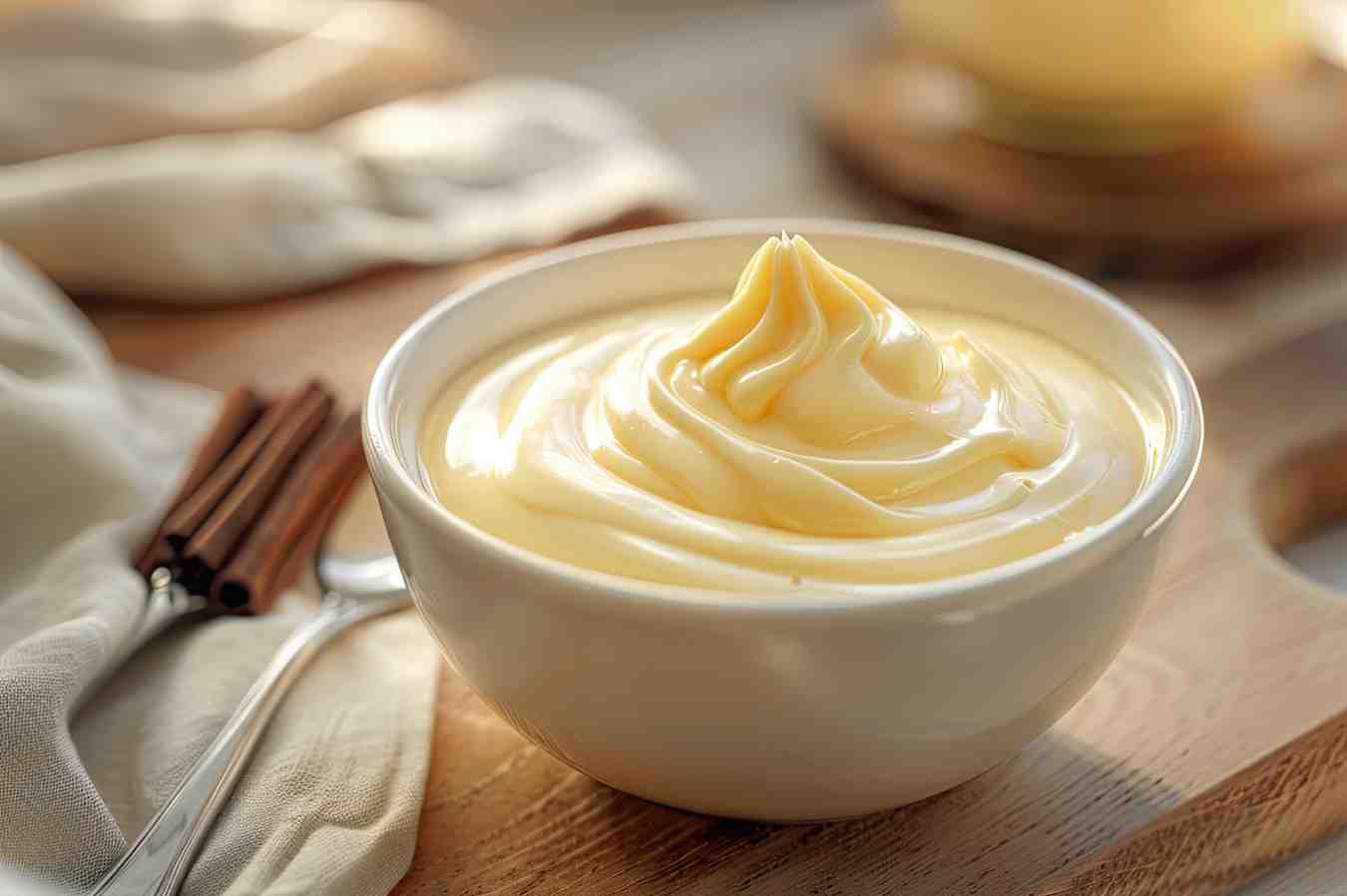Mille-feuille, a classic French dessert, has delighted pastry lovers since the 17th century. Its name, meaning “a thousand leaves,” reflects the many layers of crispy puff pastry that characterize this indulgent dessert. Traditionally, it features crème pâtissière, but over time, variations such as keto and vegan-friendly cream fillings have appeared to suit modern dietary preferences.
Traditional Creams in Mille-feuille
The traditional version of Mille-feuille uses several rich, indulgent creams to complement the crisp pastry layers. These include pastry cream, diplomat cream, whipped cream, and mousseline cream. Each offers a different flavor and texture, adding depth to the dessert.
1. Pastry Cream (Crème Pâtissière)
Pastry cream serves as the classic filling for traditional Mille-feuille. French chefs have used this thick, custard-like cream in pastries for centuries, helping to elevate Mille-feuille into the iconic dessert it is today.
- Historical Significance: Pastry cream first appeared in 17th-century French cuisine. Since then, it has become a foundation for many European desserts.
- Ingredients: Whole milk, sugar, egg yolks, cornstarch, and vanilla extract.
- Texture and Flavor: Pastry cream offers a thick and smooth texture, enhanced by the warm, aromatic flavor of vanilla. Its richness pairs perfectly with the lightness of puff pastry.
- How You Make It: Begin by heating the milk with vanilla while whisking the egg yolks, sugar, and cornstarch in a separate bowl. Gradually combine the hot milk with the egg mixture, then cook the mixture until it thickens. Once cooled, the pastry cream is ready to be used.
2. Diplomat Cream (Crème Diplomate)
Diplomat cream provides a lighter alternative to the dense pastry cream, achieved by folding whipped cream into the mix. This combination creates a smoother, airier texture.
- Ingredients: Pastry cream and whipped cream, with optional gelatin for added stability.
- Texture and Flavor: Light and airy, diplomat cream offers a creamier texture without the heaviness of traditional pastry cream.
- Uses: This cream works best for those who prefer a more delicate filling that maintains the richness of the original version. Its stability also allows it to hold its shape well over time.

3. Whipped Cream (Crème Chantilly)
Whipped cream, or crème Chantilly, adds a touch of simplicity to Mille-feuille, offering a light and fluffy alternative to the denser creams.
- Historical Context: Whipped cream emerged in the kitchens of Chantilly, France, during the 16th century, quickly gaining popularity in various European desserts.
- Ingredients: Heavy cream, sugar, and vanilla extract.
- Texture and Flavor: With a light, airy texture and a subtly sweet flavor, whipped cream balances the crisp layers without overwhelming them.
- How You Make It: Whip the cream with sugar and vanilla until soft peaks form, then use it as a creamy filling for the pastry.
4. Mousseline Cream (Crème Mousseline)
For those who want an even richer filling, mousseline cream delivers by blending butter with pastry cream. This combination results in a luxurious, velvety texture.
- Ingredients: Pastry cream and softened unsalted butter.
- Texture and Flavor: Mousseline cream provides a rich, buttery texture that adds a level of decadence to Mille-feuille.
- How You Make It: After preparing pastry cream, fold softened butter into the mixture. This process creates a smooth, creamy filling that holds up well in layered desserts.

Keto-Friendly Cream Options for Mille-feuille
As keto diets have grown in popularity, low-carb alternatives to traditional cream fillings have emerged. These keto-friendly options allow dessert lovers to enjoy the creamy indulgence of Mille-feuille without the sugar and carbs.
1. Keto Pastry Cream
Keto pastry cream offers a sugar-free, low-carb version of the traditional crème pâtissière. Although the ingredients differ, this version retains the rich, custard-like texture of the original.
- Ingredients: Heavy cream, egg yolks, erythritol (or monk fruit sweetener), and xanthan gum.
- Texture and Flavor: Rich and creamy, keto pastry cream closely mimics the smooth texture of its traditional counterpart, but without the sugar.
- How You Make It: Replace the sugar with a keto-friendly sweetener, and use xanthan gum instead of cornstarch as a thickening agent. Heat the mixture and cook until it thickens, then cool and layer it between the puff pastry.
2. Keto Whipped Cream
Keto whipped cream presents a light, airy option for those following a low-carb lifestyle. It provides the same fluffy texture as traditional whipped cream, without the carbohydrates.
- Ingredients: Heavy cream and powdered erythritol or monk fruit sweetener.
- Texture: This cream is light, fluffy, and subtly sweet, making it a perfect complement to keto pastry layers.
- Uses: Keto whipped cream can be spread between the pastry layers or combined with keto-friendly fruits for added flavor.

3. Keto Buttercream
For a more stable, thicker option, keto buttercream serves as a perfect filling. It provides a rich and structured texture, ideal for creating defined layers in keto Mille-feuille.
- Ingredients: Butter, powdered keto sweeteners, and vanilla extract.
- Texture and Flavor: Keto buttercream is smooth and creamy, with a buttery richness that complements the crisp layers of puff pastry.
- How You Make It: Whip butter with keto-friendly sweeteners and vanilla until smooth, and then layer the buttercream between the pastry sheets.
Vegan Cream Options for Mille-feuille
With the rise of plant-based diets, vegan cream alternatives for Mille-feuille have gained popularity. These dairy- and egg-free creams provide a cruelty-free option that still delivers flavor and texture.
1. Vegan Pastry Cream
Vegan pastry cream offers a plant-based version of the classic crème pâtissière. Made with non-dairy milk and other plant-based ingredients, this cream mimics the original in texture and flavor.
- Ingredients: Plant-based milk (such as almond, soy, or coconut), cornstarch, sugar, and vanilla extract.
- Texture and Flavor: Vegan pastry cream is thick, creamy, and closely resembles its traditional counterpart in texture. Its flavor depends on the choice of plant-based milk.
- How You Make It: Simmer the plant-based milk with cornstarch and sugar until it thickens. Once it cools, the cream becomes the perfect vegan filling for Mille-feuille.
2. Coconut Cream
Coconut cream, made from chilled coconut milk, provides a thick, dairy-free filling with a hint of tropical flavor.
- Ingredients: Coconut milk, vanilla extract, and sugar or sweeteners.
- Texture: Coconut cream is thick and smooth, making it an ideal vegan alternative for rich, creamy fillings.
- How You Make It: Chill the coconut milk, then whip it with vanilla and sweeteners until thick. This mixture works beautifully in vegan versions of Mille-feuille.
3. Cashew Cream
Cashew cream offers a nut-based alternative to traditional fillings, providing a slightly nutty flavor that pairs well with puff pastry.
- Ingredients: Soaked cashews, water, and sweeteners.
- Texture and Flavor: Cashew cream is rich and smooth, with a subtle nutty taste that adds depth to the dessert.
- How You Make It: Blend soaked cashews with water and sweeteners until the mixture becomes creamy. Once prepared, it can be used as a filling in vegan Mille-feuille.
4. Vegan Whipped Cream
Vegan whipped cream, made from plant-based ingredients such as coconut cream or aquafaba (chickpea water), offers a light and fluffy alternative to traditional whipped cream.
- Ingredients: Coconut cream, aquafaba, or store-bought vegan whipped cream.
- Texture: Light, airy, and smooth, vegan whipped cream works well in layered desserts.
- Uses: You can layer vegan whipped cream between sheets of puff pastry for a light, plant-based version of Mille-feuille.
Traditional vs. Keto vs. Vegan Creams
Each type of cream has distinct characteristics that make it suitable for different versions of Mille-feuille. Understanding these differences will help in deciding which option works best for your version of this classic pastry.
Taste and Texture
The flavor and texture of the cream used in Mille-feuille are crucial to the overall experience of the dessert. Let’s examine how each cream stacks up in these aspects.
Traditional Creams
- Taste: Traditional creams, like crème pâtissière and mousseline cream, are rich and flavorful due to their use of dairy, eggs, and sugar. These creams offer a sweet, custardy flavor with hints of vanilla, which pairs perfectly with the buttery, flaky layers of puff pastry.
- Texture: Pastry cream is thick and smooth, providing a rich contrast to the crisp pastry. Mousseline cream, with added butter, has a silky texture, while diplomat cream offers a lighter, airier feel due to the incorporation of whipped cream.
Keto Creams
- Taste: Keto creams substitute sugar with keto-friendly sweeteners like erythritol or monk fruit. This substitution results in a slightly less sweet flavor, but they still provide a satisfying richness. Keto buttercream and pastry cream, for example, have a creamy, buttery taste that mimics traditional creams.
- Texture: Keto pastry cream is thick and creamy, similar to traditional pastry cream, while keto whipped cream is light and fluffy. Keto buttercream, meanwhile, offers a denser texture, which holds up well in layered desserts.
Vegan Creams
- Taste: Vegan creams, like coconut cream and cashew cream, bring a different flavor profile to the Mille-feuille. Coconut cream adds a subtle tropical flavor, while cashew cream introduces a nutty undertone. Vegan pastry cream, made with plant-based milk, can take on the flavor of the milk used, such as almond or soy.
- Texture: Vegan pastry cream is thick and custard-like, closely resembling traditional pastry cream. Coconut cream provides a smooth, rich texture, and vegan whipped cream is light and airy, similar to dairy-based whipped cream.
Suitability for Dietary Preferences
Each cream type caters to specific dietary needs. Whether you’re making a traditional Mille-feuille, or a keto or vegan version, the cream you choose should align with the eater’s dietary requirements.
Traditional Creams
- Dietary Suitability: Traditional creams contain dairy, eggs, and sugar, making them unsuitable for those following keto, vegan, or lactose-free diets. However, they work well for those without dietary restrictions who seek an authentic, indulgent French pastry experience.
Keto Creams
- Dietary Suitability: Keto creams are specifically designed for low-carb, high-fat diets. By using alternative sweeteners and eliminating high-carb ingredients like sugar and cornstarch, these creams allow those on a ketogenic diet to enjoy Mille-feuille without breaking their dietary restrictions.
Vegan Creams
- Dietary Suitability: Vegan creams cater to those avoiding animal products, making them suitable for vegans, lactose-intolerant individuals, or those with egg allergies. These creams use plant-based ingredients to replicate the texture and richness of traditional dairy-based creams, making them perfect for a cruelty-free version of Mille-feuille.
Stability in Mille-feuille
The stability of the cream is a key factor in creating Mille-feuille, as the pastry requires a filling that can hold its shape while layered between crisp pastry sheets. Let’s compare how each cream performs in terms of stability.
Traditional Creams
- Stability: Traditional creams, particularly mousseline cream and pastry cream, are highly stable. Pastry cream holds up well between the layers of puff pastry without weeping or losing its structure. Mousseline cream, enriched with butter, is even more stable and perfect for making a Mille-feuille that will hold its shape for longer periods.
Keto Creams
- Stability: Keto pastry cream and buttercream provide excellent stability. Keto buttercream, in particular, has a firm texture that maintains its shape well, making it ideal for creating distinct layers in a keto Mille-feuille. Keto whipped cream is lighter and less stable, so it is best used for immediate serving.
Vegan Creams
- Stability: Vegan creams vary in stability. Vegan pastry cream, made with plant-based milk and cornstarch, provides a thick and stable filling that holds up well between pastry layers. Coconut cream, when properly chilled, can also offer good stability, but it may soften quickly at room temperature. Cashew cream tends to be more stable than coconut cream due to its thicker consistency.
Comparison Table: Creams for Mille-feuille
| Aspect | Traditional Creams | Keto Creams | Vegan Creams |
|---|---|---|---|
| Taste | Rich, sweet, and custardy with vanilla | Slightly less sweet, creamy, and buttery | Nutty (cashew) or tropical (coconut) |
| Texture | Thick, smooth, silky (mousseline); light (diplomat) | Creamy (pastry cream); light (whipped cream) | Thick and custard-like (pastry cream); smooth (coconut) |
| Stability | Highly stable (pastry cream, mousseline) | Excellent (keto pastry cream, buttercream) | Varies (stable: vegan pastry cream; softer: coconut cream) |
| Dietary Suitability | Contains dairy, eggs, sugar | Low-carb, sugar-free, keto-friendly | Vegan, dairy-free, egg-free |
FAQs
1. What is the best cream for a classic Mille-feuille?
The best cream for a classic Mille-feuille is crème pâtissière, also known as pastry cream. It provides the perfect balance of sweetness and richness, with a custard-like texture that pairs beautifully with the crisp pastry layers.
2. Can you make Mille-feuille with keto-friendly ingredients?
Yes, you can! Keto pastry cream, keto whipped cream, and keto buttercream are all great options for making a low-carb version of Mille-feuille. These creams provide the richness and texture of traditional fillings without the carbs.
3. Is vegan Mille-feuille possible?
Absolutely. Vegan pastry cream, coconut cream, and cashew cream offer plant-based alternatives to traditional creams. These creams replicate the texture of dairy-based fillings while being completely free from animal products.
4. Can I use store-bought cream for Mille-feuille?
You can use store-bought cream for convenience, especially if you’re short on time. Many keto and vegan-friendly whipped creams are available in stores. However, homemade versions generally provide better texture, flavor, and control over ingredients.

